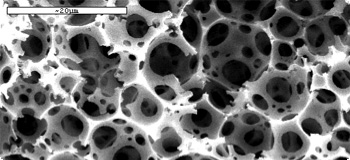alvetex® 3D Cell Culture Technology
AMSBIO offers alvetex® a synthetic scaffold for routine 3D cell culture.
Traditionally, cultured cells normally grow on treated-polystyrene 2D surfaces as in standard cell culture plastic-ware. alvetex® presents cells with the equivalent growth substrate but in a 3D format. These materials are readily adaptable to different types of existing tissue culture plastic-ware (e.g. multi-well plates, well inserts). The culture device is pre-fabricated, sterile, is ready to use off-the-shelf and can be handled in a similar manner as standard 2D plastic-ware.In addition to these products, AMSBIO offer the most advanced and extensive range of 3D tools to the life science community. Want to learn more about it? Have a look at our '3D Cell Culture in Drug Discovery and Disease Modeling' Webinar!
alvetex® Benefits
Consistent Structure
Based on existing cell culture material
Stable and inert
Adaptable to existing cell formats
Compatible with current methods of analysis
alvetex® is a highly porous polystyrene scaffold engineered into a 200µm thick membrane which provides a 3D space into which cells can invade, proliferate and grow. The vertical axis of the third dimension essentially enables additional layers of cells to form complex 3D interactions with adjacent cells simulating the structure of a tissue.
Product Range
alvetex® is available in a range of formats designed with ease of use and flexibility in mind:
-
alvetex® presented in a multi-well plate format is ideal for short-term cultures and techniques such as transfection.
-
alvetex® mounted in our well insert bathes the 3D culture in medium from above and below enabling long-term culture. Our well insert holder mounted in a deep Petri dish provides a larger volume of medium to further optimize growth of long-term 3D cultures, and enables co-culture studies (2D and 3D; or 3D and 3D).
*Inserts not included
- Download alvetex® Format Guide  - Download alvetex® Scientific Articles Review
- Download alvetex® Scientific Articles Review  - Download Hints & Tips for Successful Confocal Microscopy of 3D Cell Cultures
- Download Hints & Tips for Successful Confocal Microscopy of 3D Cell Cultures 
alvetex® advantages
These are distinct advantages over existing 3D culture products which are technically more difficult to use, have a finite shelf life and are expensive.
Importantly, alvetex® can be used for routine 3D cell culture, as an inert plastic, alvetex® is a 3D culture product which can be treated in the same manner as traditional 2D cell culture plastic. The scaffold can be plasma treated without any detrimental effect to its structure. alvetex® is sterilised using gamma radiation. In other words, its manufacture is compatible with standard culture-ware production. Furthermore, the use of polystyrene as a cell growth substrate is well accepted and recognised. These are essential attributes that make alvetex®attractive as a solution for routine 3D cell culture in any research laboratory culturing cells.
alvetex® 3D cell cultures can be studied using a variety of standard molecular and cellular assay techniques.
Assays compatible with alvetex®
- Tissue processing, fixation, embedding and sectioning
- Histological staining, in situ hybridisation
- Bright-field microscopy and photographic imaging
- Electron microscopy - both SEM and TEM
- Cryostat sectioning
- Immunocytochemistry
- Fluorescence microscopy, confocal, laser capture
- Isolation of viable cells for passaging
- Flow cytometry and cytospinning
- Extraction of nucleic acid and total protein
- Biochemical assays
Technical Downloads










